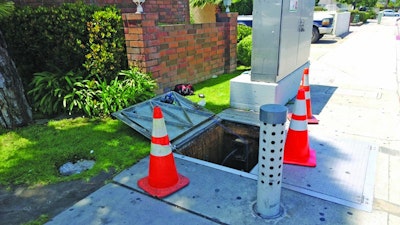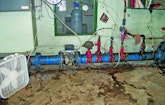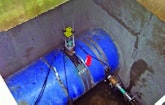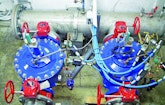Interested in Infrastructure?
Get Infrastructure articles, news and videos right in your inbox! Sign up now.
Infrastructure + Get AlertsAffordable, fast method sought for low-level organics monitoring
Problem: Organic contaminates cause ecological problems at low concentrations that are expensive to investigate. The State of Washington has legacy PCBs and PBDEs in the Spokane River. Contaminates of emerging concern are also expensive to investigate. The USGS sought alternative methods to produce quantitative results.
Solution: The Washington Department of Ecology (DOE) used the C.L.A.M. (Continuous Low-Level Aquatic Monitor) from C.I.Agent Storm-Water Solutions to field extract high volumes of water for inexpensive analysis of organics at low concentrations. The USGS compared the C.L.A.M. to the POCIS passive sampler and filtered grab samples for CECs. Both technologies provided a time-integrative extraction event, but the C.L.A.M.’s event was captured within 24 hours on standard laboratory SPE media that was extracted under standard laboratory methods and analysis procedures to produce both qualitative and quantitative defensible data.
Result: Multiple deployments in multiple locations extracted 59 to 88 liters of water, giving a much larger sample size than the typical 1-liter grab sample. For each deployment, a small disk housing pre-filtration and HLB media was all that was sent to the laboratory. Standard laboratory techniques gave parts per quadrillion concentrations of PCBs and PBDEs with precision of samples deployed in triplicate. The Washington DOE has since used the C.L.A.M. repeatedly for organics analysis. 562/619-8708; www.ciagent-stormwater.com.
Lift station backup monitors provide data and alarms for emergency response
Problem: Early New Year’s Day 2014, a drunk driver collided with two power poles in El Segundo, Calif. More than 4,000 Edison customers lost power, including seven sewer lift stations. Due to ongoing alarm issues, the telemetry communication system had been disabled at three sites.
Solution: SmartCover level monitors from Hadronex had been installed for independent backup. “SmartCover [data] enabled us to prioritize the most critical lift stations, responding with backup generators and emergency pumps,” says El Segundo Utility Manager Gil Busick. “Partway through the 18-hour outage, the power was restored. On-call employees returned home. One hour later we began receiving SmartCover level alarms once again.” The power failed once again as the electrical distribution system became overloaded. Three staff members shuttled two generators between four lift stations guided by SmartCover data and avoided any spills.
Result: Utility workers were able to access the SmartCover website via smartphones. “This worked out great as I could remotely check levels at the different stations and know where to tow the generators next,” says Busick. With wet-well flow volumes being very high and the stations being directly adjacent to the Pacific Ocean, any spill would have been catastrophic. The level monitors kept that from happening though. “I was able to enjoy the holidays rather than writing up spill reports,” says Busick. 760/291-1980; www.mysmartcover.com.
Electromagnetic flowmeter survives flood
Problem: The Village of Windsor, N.Y., was seeking to replace an older mechanical flowmeter that continually failed and needed constant maintenance. The flowmeter is used at the aquifer source for potable water distribution to measure the volumetric flow rate of all the water extracted from the wells and pumped into the village distribution system and storage tank.
Solution: The village purchased an AQUAFLUX electromagnetic flowmeter from KROHNE in 2003. Made with a fully welded corrosion-resistant housing, the meter comes standard with an IP 67 rating (equivalent to NEMA 6), and is suitable for ground burial.
Result: In 2006, after the meter had been working reliably for three years, the Village of Windsor was hit by a major flood. The magmeter was totally submerged about 2 feet below the surface of the flood waters for three days. After the flood receded, operators found that the meter continued to perform well while under the noxious flood waters, even though submersible capabilities had not been one of the intended qualities of the original design. In 2011, the magmeter was again fully submerged for about two days with the same results. The overall operational costs were significantly reduced. 800/356-9464; http://us.krohne.com.
Mag flowmeter solves tough application challenges
Problem: The Water Division in Cedar Rapids, Iowa, needed to replace under-performing flowmeters at two booster stations. The existing meters were maintenance intensive and susceptible to electrical and radio frequency interference from station equipment. The booster stations presented additional challenges in space constraints and irregular flow profiles, making accurate measurement even more difficult.
Solution: The city selected the FPI-X dual-sensor electromagnetic flowmeter from McCrometer. Its dual-sensor configuration is designed to deliver accurate measurement in challenging conditions of severe swirl, multiple pumps, line size variation and interference issues.
Result: The meter’s insertion-style design allowed simple, quick installation within the tight space requirements. There was no need to interrupt service or use heavy equipment. The flowmeter eliminated maintenance issues, saving labor and time. Reliable and accurate flow data allows the utility to optimize the benefits of its SCADA system. 800/220-2279; www.mccrometer.com.
Control valves solve flow control and pressure issues
Problem: Donnacona, an industrial town west of Quebec City in Canada, had poor flow control at its water treatment plant due to high drops in pressure. The pressure range available at the plant inlet varied between 10 and 58 psi, with a low back pressure available (lower than 10 psi) for the valve. This translated into a pressure range drop across the valve of 2 to 53 psi.
Solution: The town installed 106-PT-4SC-AC and 106-2SC-PCO 8-inch hydraulic globe valves from Singer Valve in parallel, with one having an anti-cavitation cage. The operator sets the flow setpoint, and the controller adjusts the flow to ensure that the required level is maintained in the distribution channel. On low flows, the controller controls the 106-PT-4SC-AC anti-cavitation valve depending on the setpoints of the level and flow controllers. When the valve reaches a set position and the flow setpoint has not been achieved, the controller switches to the 106-2SC-PCO and controls the valve. When the setpoint is lowered where the valve position is below the set position, it is fully closed, and control resumes on the anti-cavitation valve.
Result: The two valves coordinate based on the pressure differential, and the water level is now maintained. 888/764-7858; www.singervalve.com.










